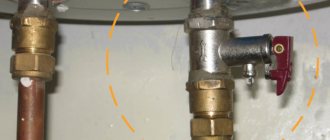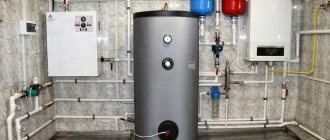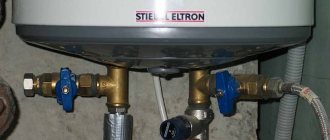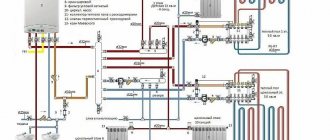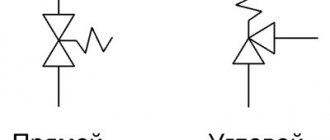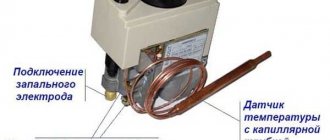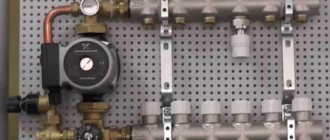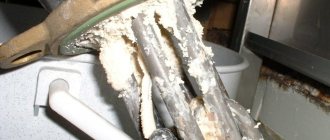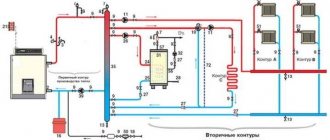All well-known manufacturers of water heating and heating equipment take their reputation in the market and in the consumer environment very seriously, therefore they do everything to ensure that accidents and accidents when using their products are excluded. All boilers that heat water under pressure of more than 1 bar are tested on special stands and installations. But even in this case, manufacturing companies remind in the instructions that it is mandatory to install a safety valve for the boiler. This is the only way to ensure the required level of security.
Safety valve, device and installation features
From the name alone, you can easily understand that the main function of the safety valve is to control the pressure inside the boiler. In fact, the design of a standard device includes two valves - a check valve and a safety valve, Fig.
To understand how to work with the structure, you need to understand the design of the boiler safety valve:
- Both control valve elements are assembled in a T-shaped body made of nickel, iron-aluminum or brass alloy. A check valve is installed in the vertical part of the housing, and a safety valve is installed in the horizontal part;
- A red or blue control flag is installed on the fuse rod, with which you can forcibly discharge some of the water from the boiler;
- The control plates or petals of both valves in operating condition must be pressed against the supporting surface or “seat”;
- There is an inch pipe thread at both ends of the inlet and outlet pipes of the housing, most often its size on the safety valve for a boiler is ½ inch. For 100-200 liter tanks, a ¾-inch boiler safety valve is usually provided.
For your information!
Despite the fact that both valve elements are installed in the same housing, they work and break down in completely different ways. As an example of a high-quality device, we can recall the safety valve for a Gorenje boiler, photo.
The brass body and high-pressure casting ensure long service life even when installed on cheap Chinese boilers. The only drawback is the high price, at least $15 per piece. But if you consider that installing a valve fuse will avoid major troubles, it makes no sense to skimp on safety.
Safety valve activation
It is worth noting that both valve elements, despite the fact that they are installed in the same housing, operate completely independently of each other. The valve fuse operates in many ways similar to an automatic boiler valve. As soon as the pressure inside the container increases above the limit of 6 bar, the shut-off plate moves under water pressure, compresses the spring and releases the drain hole. Some of the water goes down the drain until the pressure equalizes to normal.
In addition, a safety valve for the boiler with a release handle allows you to clean the container from accumulated salts and sediment. To do this, once every couple of weeks you need to install the handle or flag in a horizontal position. In some models, you will need to press the flag and hold it for several minutes. Water through the drain flushes away particles and sediment accumulated in the valve mechanism.
Advice! Using a valve fuse, you can completely drain the water from the boiler for repair or maintenance.
The check valve is designed to prevent warm water from flowing from the boiler back into the supply water line. As the water in the heating tank is consumed, the locking plate rises under pressure in the line and releases the flow part to fill the boiler.
If the pressure in the water supply system sharply decreases or increases, the valve plate blocks the flow of hot water back into the main line or dampens the water hammer using a spring. It is especially important to install a safety valve for a boiler on cheap Chinese products that do not have thermostats or thermal electric relays.
Without installing a check valve and a safety valve, a Chinese boiler can easily turn into a source of danger - scalding the owners with boiling water or flooding the apartment with hot water. Master practitioners often admit that it makes sense to install a safety valve even for an indirect heating boiler, which by default should not have such problems. For example, repair work on water supply systems is almost always accompanied by water hammer and pressure surges, in which case the boiler is subjected to rigorous testing, regardless of its design.
Complaints regarding the operation of the safety valve
In fact, abnormal operation of the valve device may have very specific reasons:
- Low quality product;
- Abnormally high pressure in the water supply;
- Incorrect installation and adjustment of the valve mechanism.
As a rule, high water pressure is typical for the first floors of apartment buildings. When installing professionally, technicians are always interested in water pressure. It is impossible to install a boiler and connect it to a water supply with water at 5-6 bar. Therefore, they try to regulate the pressure using an inlet valve or recommend installing a reduction gearbox, which will immediately solve half the problems.
The first and third cases are much more complex and dangerous than high blood pressure. As a rule, manufacturers of well-known brand boilers complete their products with very good, high-quality safety valves. When purchasing, few people check exactly what additional components and materials are included with the boiler, so branded devices are replaced during pre-sale preparation by those that are the same size, but cheaper. Therefore, when purchasing or installing, it is worth checking the operation of the device again, so as not to be surprised later that the safety valve on the boiler is leaking.
High valve quality can be determined by the following characteristics:
- The body is made of cast brass alloy, possibly with nickel plating. Cheaper iron-aluminum or copper-aluminum alloys will be lighter, with thinner body walls;
- Plastic valve plates, when pressed on the stem, touch the inner walls of the body or become wedged in an extreme state;
- The mechanism inside the valve does not ensure reliable closure of the flow even at low pressures. To check, you can press the valve stem with your finger and blow into it. If there is no reliable locking, then it is better to replace the safety valve. Moreover, if the boiler drips from the safety valve, this does not mean that the device is faulty. Most likely, the locking plate is clogged with sediment, but the mechanism itself is in working order and does not require additional adjustment.
If there is no water at all, or the water flows in a stream, this indicates that the valve plate is jammed in one of the extreme positions. The device will require dismantling, cleaning and adjustment.
But even if the boiler and safety valve are selected correctly and of the required quality, there remains a risk of improper installation and adjustment of the system by craftsmen. For example, it is not uncommon for a hot water safety valve to be installed on a boiler. To avoid finding yourself in a similar situation, it is enough to have at least a general understanding of how to install and adjust the safety valve.
The valve drips when the boiler is on
Thermostatic valve: types and installation methods
The situation is simulated with the water heater turned on without water draw-off.
- The cause of water discharge will be a broken valve.
This is explained simply: when the liquid is initially heated, its volume increases by 3%. This excess is discharged into the sewer. But after that, the heating device simply keeps the water at a constant temperature. The valve should not drip.
The appearance of drops indicates a malfunction of the device or it is clogged with debris.
- The second situation under consideration paints a picture of the correct operation of the mechanism.
The water heater operates with increased water consumption (showering). The volume of hot water leaves, and cold liquid comes in its place. The new supply begins to heat up - “new” excess water appears, which is continuously discharged into the sewer.
- The third situation arises when water withdrawal is extended over time. Water discharge should not be constant. The safety valve drips periodically. This indicates that the device is working correctly.
For example, washing dishes. The water collection process is extended. Water should also not drip constantly.
Installation diagram of the device on the boiler
There are few requirements for correct installation of the valve device:
- The safety valve is always installed in the gap in the cold water line between the shut-off valve and the inlet to the boiler; no other devices should be placed in this gap;
- The maximum distance from the inlet pipe on the boiler to the valve fuse is 180-220 cm;
- For most models, the device is installed vertically, with water flowing from bottom to top. The direction of movement of the water flow is indicated by an arrow on the body.
The drain fitting on the safety valve must be connected by a transparent PVC pipe to the sewer line. The transparent tube is very convenient to use - you can clearly see how the safety valve works.
In order not to drill or cut the sewer pipe, you can use a special tee for washing machines, as in the video
Before installation, the body is carefully purged with air to avoid a loose fit of the plate to the seat due to debris or scraps of packing tape accidentally getting inside. The valve is assembled according to the traditional scheme - the threads are wound up with a hammer in the direction of tightening the union nut and twisted with the inlet or underwater hoses.
Before starting the boiler, the cold connection is pressurized under operating pressure. If no water droplets appear at the joints within 5-7 minutes, it means the installation was completed correctly.
After filling the boiler, it is necessary to check the operation of the safety and check valves. The test is carried out “cold”. The correct adjustment of the emergency water discharge can be checked with a flag. With a slight pressure, about 1/5 of the full stroke, the first drops should appear, and with full pressure the water runs in a stream. This means that the factory settings are correct.
The operation of the check valve can be checked as follows. It is necessary to fill the boiler completely, then close the shut-off valve at the entrance to the tank and the central inlet. When you open the tap in the bathroom and kitchen, water will run out of the pipes for the first couple of minutes. If the flow does not stop even after 5 minutes, it means that the “return” does not hold and requires adjustment. The flow of water from the boiler can be indirectly monitored by the pressure drop on the pressure gauge.
Only dismountable valve models can be adjusted directly. For this, special thin metal washers with a thickness of 0.2-0.3 mm are used. They are placed under sagging springs, and thereby the elasticity of the part is experimentally selected. Non-separable valves are replaced with new ones.
Correct installation of the safety device
1. First, disconnect the boiler from the power supply and drain the water from it. 2. We install the device for the cold water supply at the inlet of the heater. We pack it in the usual way and connect cold water to the second side. There is an arrow on the valve body that indicates the direction of the water; when installed, it should point towards the boiler. 3. We connect the pipe that comes from the blast valve with the sewer. Sometimes it is purchased transparent in order to monitor the serviceability of the safety valve. 4. After connecting the boiler completely, it is worth checking it. To do this, fill the tank by prematurely opening the valve to allow air to escape. 5. Then, after drawing water, close the tap and turn on the boiler. 6. We monitor all joints for the presence of water and look at the functionality of the safety valve. If a leak is detected, the inlet and outlet valves are closed, and the required area is repacked.
